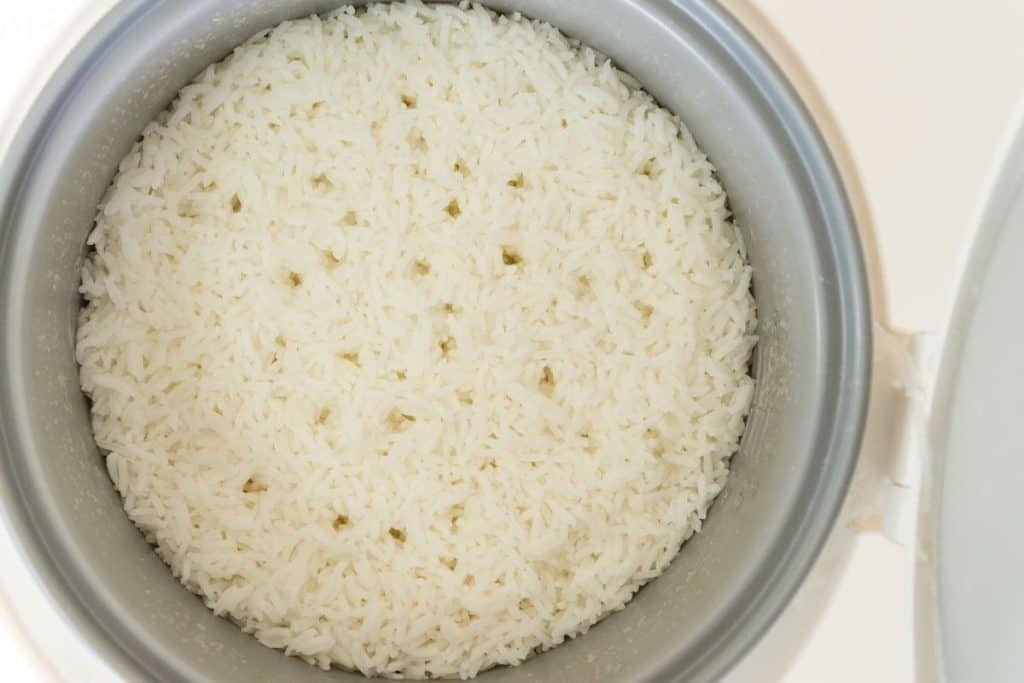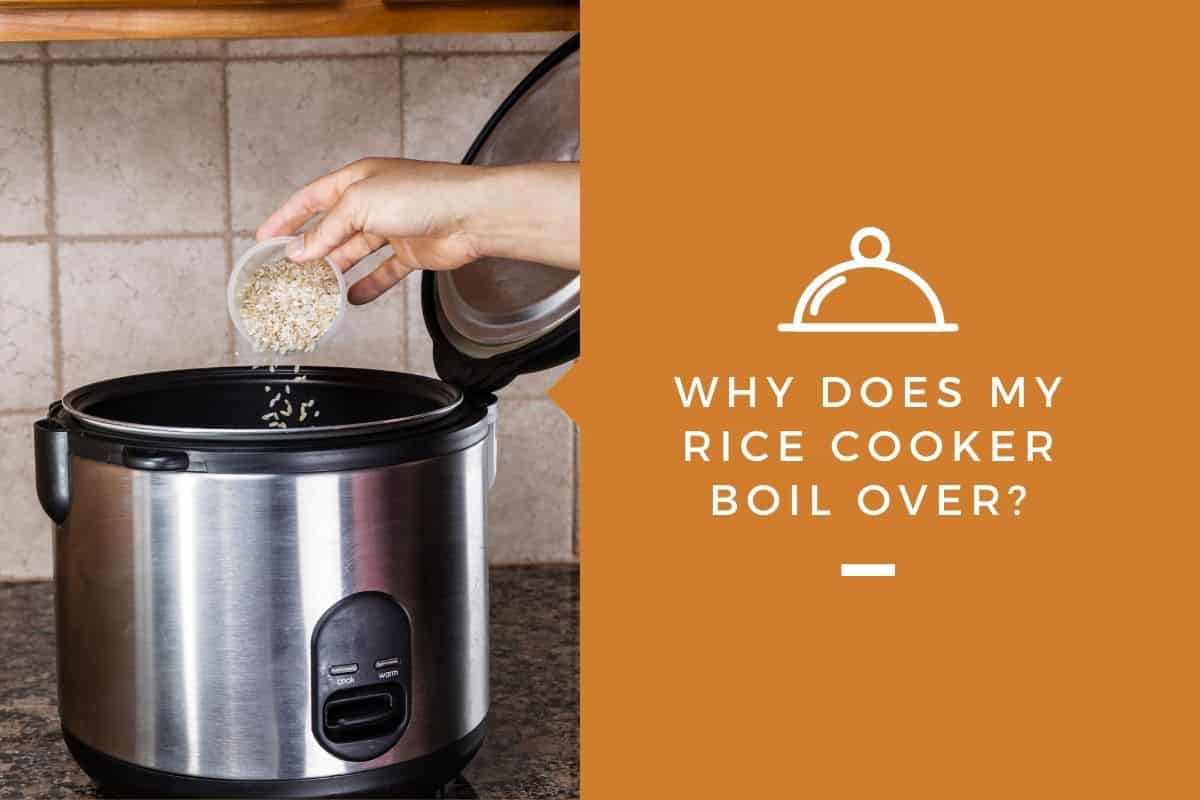Let’s face it, we have all been there. You are in the middle of preparing a delicious meal, and you suddenly hear a hissing sound from the stove. This hissing usually indicates water is hitting either the burner or flames. Likely you have a pot that is in the process of boiling over.
Why does my rice cooker boil over? Rice cookers boil over quite frequently, and there is a good reason for it. Two of the leading causes of your cooker boiling over are.
- The rice hasn’t been washed, so it is too starchy.
- The rice cooker is overfilled with either water, rice or both
You may be thinking I read the manual, and it didn’t mention washing my rice, and I used the correct measurements. Even if you think you have followed the steps recommended in the manual, read on to see if there is something you may have missed.
Wash the Rice
Chances are you purchased a rice cooker because it ensured a quick and easy way to prepare rice, without constant supervision required. Rice cookers are fabulous tools, but there are specific things you must do in order to make sure you avoid boil overs. Washing the rice is probably one of the most overlooked steps of all.
First, washing rice takes precious time. Time that you may not have, which makes it a step that is easily skipped over. Trust me, I have skipped this step many times, and many times I have spent a good amount of time scrubbing a starchy mess from my stovetop. Don’t be like me. Wash your rice!
Washing rice is quite simple, but it does take a few minutes of time. I am going to share three methods you can use when washing rice.
Method 1
For this method, you will need a finely woven colander. Make sure the rice grains can’t fit through the mesh, or else you will have a mess to clean up and no rice to cook. You will also need a large bowl, clean water, and a spoon or clean hands.
- Pour the uncooked rice into the bowl.
- Cover the rice with clean lukewarm water.
- Using your hands or spoon, stir the rice around in the bowl.
- You will notice the water will begin to turn cloudy. This is from the starch. It is okay.
- Pour the rice from the bowl into the colander.
- Empty the water from the bowl.
- Repeat steps 1-5 until the water in the bowl is nearly clear after stirring the rice.
Method 2
This method requires water and a finely woven colander.
- Pour the rice directly into the colander.
- Run lukewarm water over the rice while it is in the colander.
- Mix the rice around with your hands.
When using this method, you won’t be able to see the starch running off the rice, so you will have to judge how long you choose to rinse the rice.
Method 3
This may be the simplest method, but it is also very similar to methods 1 and 2. For this method, you will need a container with a tight-fitting lid, water, and a colander.
- Pour the uncooked rice into the container.
- Cover the rice in lukewarm water.
- Secure the lid onto the container.
- Shake the container of rice and water for about 30 seconds.
- The water will turn cloudy because of the starch. This is okay.
- Pour the contents into the colander.
- Repeat steps 1-5 until the water in the container appears clear after shaking.
All these methods will ensure that you get the excess starch off the rice prior to placing it into your rice cooker. This step alone may save you from cleaning up messy boil-overs.
I’ve Washed the Rice, but My Cooker Still Boils Over

Maybe you are an individual that makes sure the rice is starch-free before beginning, but you are still noticing a significant amount of boil over when using your rice cooker. There could be another cause that I will discuss here.
The Rice Cooker is Overfilled
There is a possibility that the rice cooker is being overfilled with either water, rice, or both. This is a much more common thing than you may think. Sure, the rice cooker comes with measuring devices and lines to show the full mark, but do you know the actual measurements for each of the included tools?
Cups and Scoops Aren’t the Same
If your rice cooker comes with a measurement device, it is likely in the form of a scoop. A lot of times, it is easy to think a scoop is equivalent to a standard measuring cup. Do NOT assume this. The typical scoops are not equivalent to one cup. Therefore if you are using a measuring cup, you are likely putting too much water or rice into the cooker.
When the cooker is overfilled, there is nowhere for the starchy bubbles to go, and that is when the rice cooker begins to boil over.
Check the Vents
Now that the washing and measurements are cleared up, boiling over may still be a problem. At this point, you are probably frustrated and think you have a defective rice cooker. While this may be the case, there are a couple of more things to check out.
If you are reading this, you have likely been plagued with multiple boil overs. Because of this, the vents on the top of the lid may be full of dried starch. If the vents are clogged, the steam will have nowhere to escape and could be causing the boiling over.
Look at the vents, if you notice a starchy look, it’s time to clean them out. Do not begin sticking toothpicks and other sharp objects into the vent. You want to clean it, not damage it. The best thing you can do is soak the lid in hot soapy water and use a toothbrush or other fine brush to gently scrub the vents until they are clear.
Check the Type of Rice
If you are frequently using brown rice, there are chances that this is the cause of the problem. Brown rice is typically starchier than white rice varieties. This makes the washing step extra important when you are trying to prevent the cooker from boiling over.
Now What
If you have followed all the above steps, up to and including cleaning the vents and monitoring the type of rice you are using, you may still be experiencing boil overs and a lot of frustration. Have no fear. There are a couple of more things you can try that are directly related to the cooking of the rice.
Add Fat
Rice is a relatively healthy option, and you may be wondering why anyone would suggest adding fat to it. When speaking of fat, I am not referring to a chunk of lard…yuck! Instead, look in your pantry and see what oils you have available.
What Oils Should I add?
I wouldn’t recommend using vegetable, canola, or grapeseed oil because the flavor isn’t going to enhance your rice in the least. However, you can add, olive, sesame, coconut, or butter to the rice. Each of these oils will not only provide a barrier to the starch, but they will also lightly flavor your rice as well.
How Do Oils Help?
The oil isn’t magical, but it does help break the foam apart. No matter how well rinsed the rice is, it is still a starchy food, and foam will develop upon cooking. The oil or fat just keeps the foam under control.
Now You Know
Knowing the reason behind your rice cooker boiling over can hopefully help you to solve the problem. If you try all the suggestions and are still seeing this happen, it may be time to reach out to the manufacturer for a replacement or, at the least, their personal suggestions.

